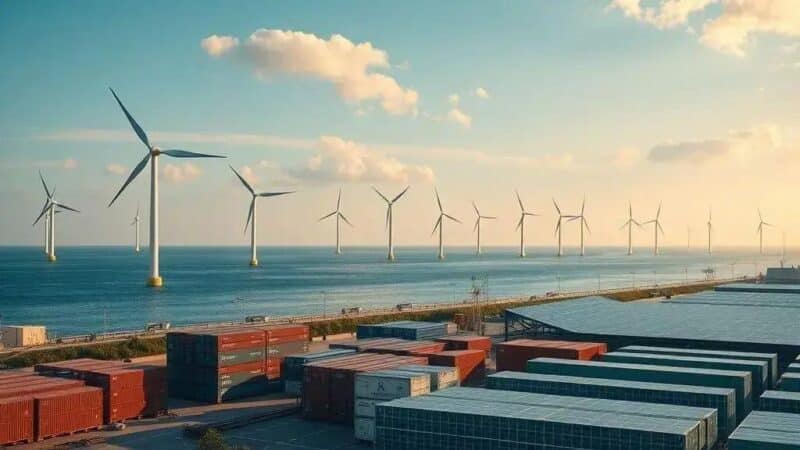Renewables are surging across Europe — yet most panels and turbines come from China. Can Europe grow green jobs and secure supply without sacrificing cost and speed? Let’s unpack the options.
Europe’s renewable expansion — fast deployment but foreign-made equipment
Europe is quickly expanding its use of renewable energy. New solar farms and wind parks are appearing fast. This rapid growth helps fight climate change and meets energy needs. It shows a strong commitment to a greener future.
However, there’s a key issue. Much of the equipment used for this expansion comes from outside Europe. For instance, many solar panels and wind turbine parts are imported. This reliance on foreign-made equipment creates a challenge.
While Europe deploys renewables quickly, it often doesn’t build the manufacturing jobs at home. This means other countries benefit from the production. This situation raises questions about Europe’s long-term energy independence and economic benefits.
The drive for quick and affordable deployment often leads to buying from global suppliers. These suppliers, especially from Asia, can offer lower prices. This makes it harder for European manufacturers to compete directly. Balancing speed, cost, and local production is a big task.
China’s manufacturing edge: scale, subsidies and lower costs
China has a huge advantage in making **renewable energy** equipment. They produce solar panels and wind turbine parts on a massive scale. This large-scale production helps them make things very efficiently. When you make a lot of something, the cost per item usually goes down.
Another big reason for China’s edge is government support. The Chinese government provides subsidies to its manufacturers. These subsidies can be financial help or other benefits. This support allows companies to sell their products at lower prices than competitors.
These two factors – massive scale and government subsidies – lead to significantly lower costs. It’s tough for other countries to match these prices. This means that many European countries find it cheaper to buy renewable tech from China. This helps Europe deploy green energy faster, but it also impacts local manufacturing jobs.
China’s ability to offer low-cost, high-volume products has made it a global leader. This dominance shapes the worldwide market for solar and wind technology. It presents a challenge for any region looking to build its own **renewables** supply chain.
Economic trade-offs: price, speed and strategic supply security
Europe faces tough choices when it comes to **renewables**. It’s a balancing act between three key things: price, speed, and keeping supplies safe. Buying cheaper solar panels and wind turbine parts from other countries helps deploy green energy fast. This keeps costs down for consumers and businesses. It also helps meet climate goals quickly.
However, relying too much on foreign suppliers has downsides. It can make Europe’s **energy security** weaker. If there are problems with global supply chains, getting parts could become difficult. This might slow down or even stop new projects. It also means fewer manufacturing jobs are created within Europe.
Building local factories for **renewable energy** equipment costs more money. It also takes time to set up and produce things on a large scale. This could mean higher prices for panels and turbines at first. But, it creates jobs and makes Europe less dependent on other nations. This strengthens its strategic supply chain.
So, leaders must decide. Do they prioritize low prices and fast deployment of **renewables**? Or do they invest more in local production for better supply security and jobs? Finding the right balance is crucial for Europe’s green future.
Policy tools: investigations, tariffs, incentives and reshoring efforts
Europe is using several ways to strengthen its **renewables** supply chain. One key method involves investigations. These look into whether foreign companies are selling products too cheaply. This practice, often called ‘dumping,’ can harm local businesses. It ensures fair competition.
Another tool is applying tariffs. These are extra taxes put on imported goods, like solar panels or wind turbine parts. Tariffs make foreign products more expensive. This helps European-made products compete better on price. The goal is to create a more even playing field.
Governments also offer incentives. These are financial helps or benefits for companies. Incentives encourage businesses to build new factories in Europe. They might get grants, tax breaks, or cheaper loans. This boosts local production of **renewable energy** technology and creates jobs.
Finally, there are reshoring efforts. This means encouraging companies to bring their manufacturing back to Europe. Instead of producing abroad, they set up factories closer to home. This helps secure the supply of important **renewables** components. It also reduces Europe’s reliance on other countries for critical parts.
Innovation as a lever: perovskite solar, high-efficiency modules and IP
Europe can gain a strong edge in **renewables** through smart innovation. Developing new technologies is a powerful way to compete. This helps create better products and new jobs right here in Europe.
One exciting area is **perovskite solar** cells. These are a new type of solar cell that could be cheaper to make. They might also be more efficient at turning sunlight into electricity. Imagine flexible solar panels that can go almost anywhere!
Advancing High-Efficiency Modules
Making solar panels and wind turbines work better is also crucial. High-efficiency modules can produce more power from the same amount of space. This means we can get more green energy without needing huge areas. It helps lower the overall cost of **renewable energy** over time.
Protecting new ideas is super important. This is known as **Intellectual Property** (IP). When European companies invent something new, like a better solar cell design, they need to own the rights to it. This stops others from copying their hard work.
Strong IP protection encourages more research and development. It helps European businesses stay ahead in the global **renewables** market. By focusing on these innovations, Europe can build its own strong supply chain and reduce its reliance on foreign technology.
Fonte: Fortune.com








